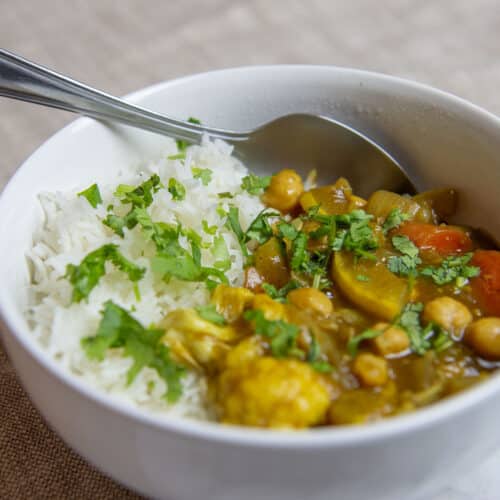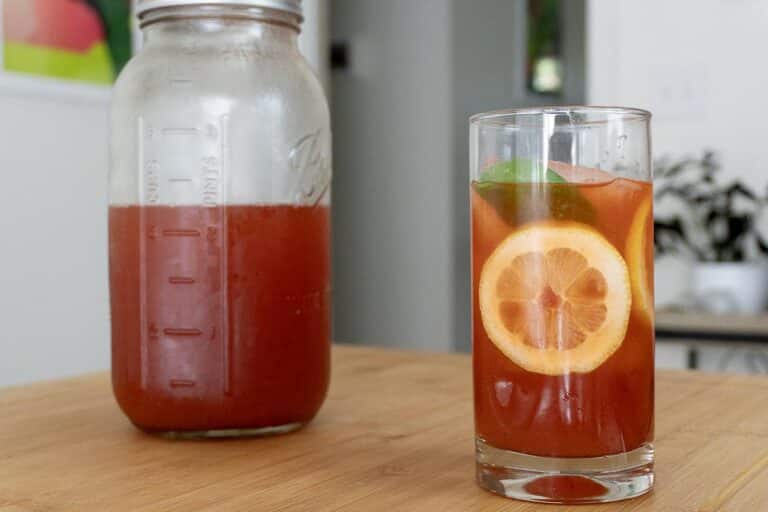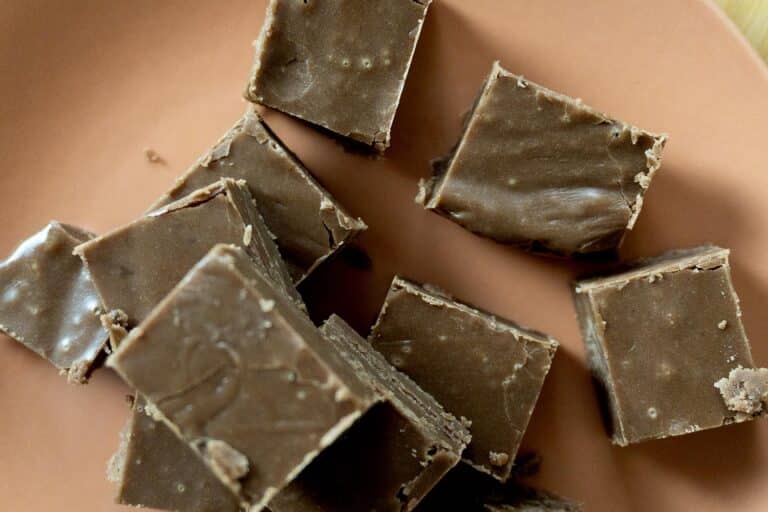Vegan Vegetable Curry Recipe
This Indian-style vegetable curry made with lots of vegetables, herbs and spices is easy to make and packed with flavor.
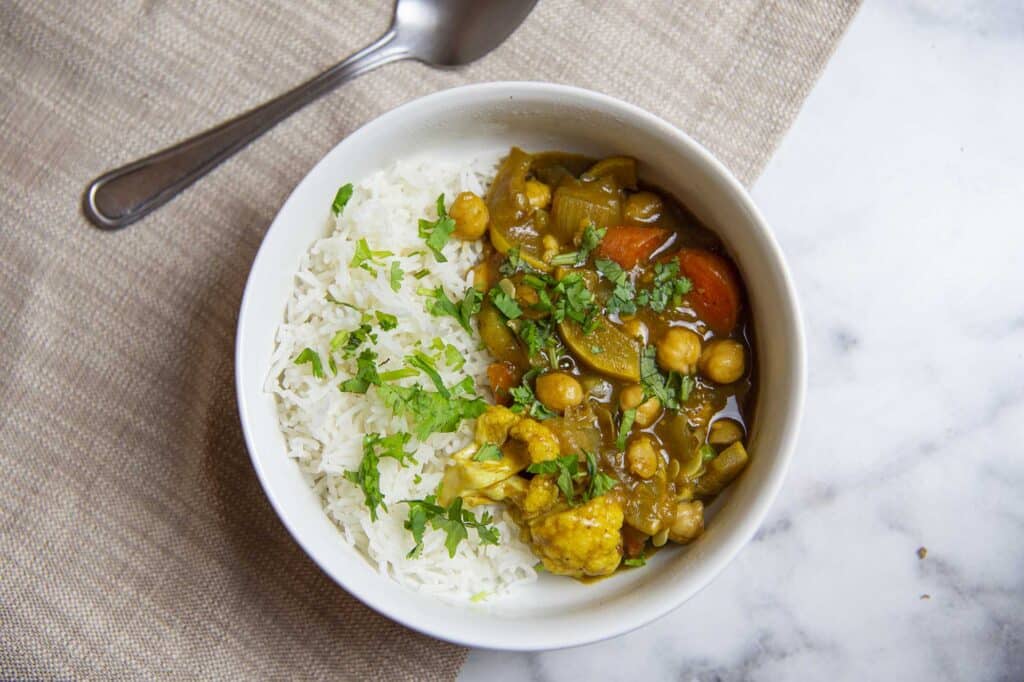
Low in fat, calories, and containing a wide variety of vegetables, this vegetable curry is a great healthy meal. It also happens to vegan and vegetarian. I like to serve this with basmati rice, but it is also delicious with roti or naan.
This vegan curry recipe is comforting and made with staples you probably already have in your pantry to build layers of flavor. The base of this dish is garlic, ginger, onions, tomatoes, chili powder, and garam masala.
Garam masala is a delicious and common Indian spice blend that varies based on region. Typically it is more pungent and sweeter than curry powder. It usually contains cinnamon, mace, cloves, cardamom, nutmeg, cumin and coriander.
This easy curry recipe is basic and highly customizable. Use whatever veggies or spice blends you want.
I also love to make this vegetarian curry when I have a lot of veggies in my fridge that are about to go bad. I like to add chickpeas for a protein source to ensure I’m not hungry again an hour later. You could add a different bean or protein source.
Add coconut milk and curry leaves to make this South Indian. Use mango powder (amchur) and fenugreek (kasoori methi) to make it North Indian.
How to make vegetable curry
This veggie curry is so easy to make. First, start by heating 2 tablespoons of oil or ghee in a pan and add cumin seeds. Once they begin to sizzle, add garlic and ginger paste.
Let that cook and get fragrant, for about a minute, and then add your onions. Sauté until lightly golden and then add your tomatoes. I used fresh chopped tomatoes but you could use canned mashed or pureed.
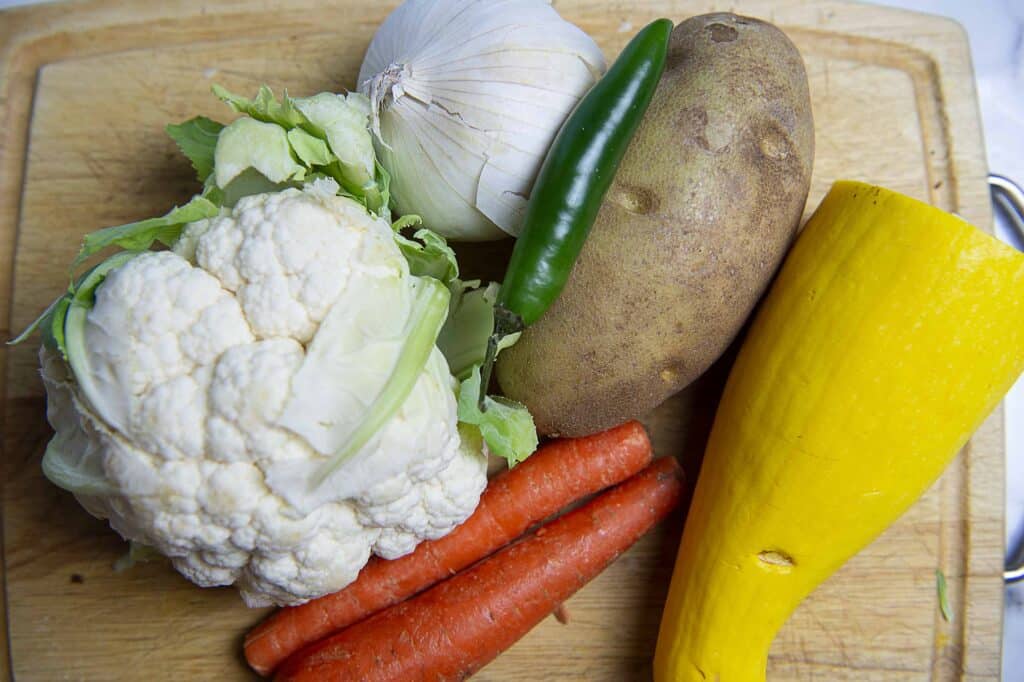
Once the tomatoes are mushy, add salt, garam masala, black pepper, and red chili powder. Let that cook for a minute and then add your veggies, except the frozen peas. I added potato, carrot, yellow squash, and cauliflower, but feel free to experiment with different vegetables.
After you have sautéed your veggies for a few minutes, add roughly one cup of water. You could use broth if you have it, but water will do just fine.
Give it a good stir, lower your temp so it’s between low and medium, and cover. Cook until the veggies are soft and then add your chickpeas and peas. After a few minutes, taste and add salt and seasoning as needed.
If you prefer a saucier curry, you can add a little more liquid. If you like it dry, you can cook off the liquid. At this point, I mix together a little of the broth and cornstarch, and then add it to the curry. Let this thicken up for a few minutes and then you’re ready to serve.
How do you thicken curry
There are many different ways to thicken a healthy curry recipe. Let’s look at some of the different methods.
– Make a slurry. I use this method in this recipe. I scoop out some of the broth (or you could use cold water). Them mix in cornstarch until there are no more lumps. Pour into the curry, bring it to a low boil, and then the sauce thickens. You could also use tapioca starch or arrowroot.
– Add dairy. Lots of curries use dairy so feel free to add plain yogurt, coconut milk or cream, or heavy cream. Curry with coconut milk is a delicious way to make the dish creamy.
– Add ground nuts. Ground up cashews or almonds will absorb some liquid and help thicken the sauce.
– Add lentils. Lentils are a very common ingredient in Indian curries. They can act as a thickening agent because they absorb liquid as they cook. If you go this route, add the lentils when you add the water, so they have more time to cook.
– Add tomato paste. Since this curry already has tomatoes in it, adding tomato paste is a great way to help thicken up the sauce.
What is the origin of the word curry
Curry actually isn’t an Indian word at all. India is such a diverse country, and their food reflects that. How is it that their wonderfully diverse array of stews and dishes is lumped into the word curry (to non-Indian folks)? Cue Portuguese and British imperialism.
When the Portuguese first arrived in India in the early 1500s, they introduced vinegar and peppers. With that they created a very Portuguese-influenced dish in Goa called vindaloo. It used many different kinds of peppers including black peppers mixed with tamarind water that they called ‘black gold.’
The Portuguese exported this out of India, eventually replacing the black peppers with red ones since they were cheaper. It’s believed that they basically white-ified the Tamil word kari (because of course they did), which means to blacken with spice.
At the same time peppers were introduced to Indian cuisine, the British East India Company was established. Soon the British were colonizing India, adapting local dishes to fit their palates. This gave birth to the curry dishes that we know today.
TLDR, British and Portuguese colonizers made the word curry popular- a way to simplify what they saw as foreign dishes that they did not take the time to understand.
In many countries, curry became a blanket term to refer to a dish with a sauce seasoned with spices associated with South Asian cuisine. There are dozens of types of curries (saucy or not) in Japanese, Thai, Indian, and other South Asian cuisines.
Curry powder is a commercially prepared mixture of spices marketed in the Western parts of the world. In the 18th century the English exported it after Indian spice merchants sold a mixture of spices (similar to garam masala) to the British army and government.
In the U.S., a commercially made curry powder usually contains turmeric, coriander, black pepper, cumin, cardamom, fenugreek, and ginger.
Store bought curry powders are usually made with old spices. That’s why we recommend using whole spices as well as traditional Indian spice blends like chaat masala and garam masala.
Curry powder is not actually a staple ingredient in Indian cooking. Curry powder was created by the British empire in the 1800s to imitate Indian flavors.
Rather than taking the time to understand and appreciate the regional diversity of Indian spices and dishes, they dulled things down and curry powder was born.
S&B curry powder is a staple in Japanese pantries. Curry powder first made its way to Japan, thanks to British imperialism again.
The British Navy brought curry powder to Japan in the mid to late 1800s. It was then sold to S&B foods in 1923.
S&B curry powder contains more than 30 kinds of roasted, blended, and aged spices. The main ingredients are turmeric, coriander, cumin, fenugreek, orange peel, and chili.
What goes with curry instead of rice

There are lots of ways to enjoy this mixed vegetable curry beyond basmati rice. Roti and naan are both delicious with this vegetable curry.
There’s nothing better than sopping up delicious curry with soft, fluffy naan. Naan is traditionally made in a clay tandoor oven, with wood or charcoal fire. The dough is then stuck to the sides of the oven and cooked at a very high heat to perfection.
Most home kitchens don’t have a tandoor oven. Instead, you can make naan using a hot cast iron skillet or oven.
Roti is another delicious option to accompany this vegetarian curry recipe. While naan is made with all purpose flour, roti is made with whole wheat flour. This is a very simple bread to make and has two ingredients- whole wheat flour and water.
If you’re watching your carb intake, you could also make cauliflower rice to eat with this simple curry recipe.
Simply use a box grater or food processor to get the cauliflower into “rice” sized pieces. You can season it and enjoy it raw, or saute it in oil for a few minutes.
Samosas are a great accompaniment to this healthy curry recipe. They are traditionally fried or baked and filled with peas, potatoes, onions, lentils, and spices.
How long does vegetable curry last in the fridge
Vegetable curry will last up to three days in the fridge.
What spices go with curry
Common spices in curries include turmeric, chilies, ginger, and cumin. Other essential spices include cinnamon, clove, cardamom, mustard seed, fenugreek, coriander, caraway, and nutmeg.
Aromatics like onion, garlic, lime, cilantro, and lemongrass go very well with curries.
How do you use curry powder
Yes, curry powder is a byproduct of British imperialism. Yes, it is not actually used in Indian cooking. But curry powder is still good to have in your pantry. Curry powder works in a wide variety of dishes, adding warmth and depth of flavor.
Use curry powder to season a soup, in a chicken salad, roasted vegetables, and part of a dry rub on proteins.
S&B curry powder is a staple in the Japanese pantry. It’s great for making a roux for a Japanese style curry.
What curry is the healthiest
There are lots of healthy options when it comes to curries, but calories can sneak up on you. Some ingredients in curries that are calorie-dense or high in fat like coconut cream, cream, ghee, oil, fatty meats like lamb, and sugar.
Curries that are lower in fat and calories can include lean proteins like beans, chicken, fish, and tofu as well as vegetables, leafy greens, and lentils.
If you’re looking for a low-calorie curry, vegetable curries like this recipe can be a really good option.
It uses very little fat, and instead of using a cream-based thickener, it uses a cornstarch slurry. Additionally, a wide variety of vegetables is high in nutritional value containing lots of different vitamins and minerals.
Also, to be clear- there is no such thing as bad food. If you are watching your calories, it comes down to how much of a food you consume and how much calories are in it.
What happens when you eat too much curry
Nothing. Other than the fact that you are eating highly delicious food and maybe enjoying life more.
Is curry an anti-inflammatory
Curry powder contains spices like turmeric, chili pepper and coriander. Turmeric contains a pigment called curcumin, well known for its ability to fight inflammation by regulating inflammatory proteins.
Additionally, chilies contain a compound called capsaicin that is a powerful anti-inflammatory and cancer fighting force. Coriander is also anti-inflammatory and used in traditional medicinal practices.
Curry powder contains lots of antioxidants that can decrease your risk of heart disease and cancer.
How do I use curry paste
Curry pastes are common in Thai cuisine and there are many different types. They contain much of the same spices as curry powder but also include ingredients like shallot, onion, lemon grass, ginger or galangal, garlic, shrimp paste, fish sauce and kaffir lime peel.
Thai curry pastes include red, green, and yellow varieties. They get their different colors from the kinds of fresh and dried chilies that are used. Yellow curry paste gets its color from fresh turmeric.
Add curry paste to the beginning of soups and stews or use it as a marinade for beef, fish, chicken or tofu.
To make a saucy curry using curry paste, add the paste to a hot skillet and add protein or veggies. Cook for a few minutes and then add stock and/or coconut milk.
Slowly simmer the liquid until it thickens and serve over rice.
Another great way to use a curry paste is to add a spoonful to yogurt to make a dipping sauce or dressing.
Can I use turmeric instead of curry powder
No, turmeric is not a substitute for curry powder. Curry powder is a mixture of spices with a golden hue including turmeric, coriander, cumin, fenugreek, chili pepper, and more.
Using turmeric instead of curry powder will give you the same golden color as curry powder. However you will not have any of the flavor and your food will be very bland.
If you use turmeric in place of curry powder, be sure to season your food with coriander, cumin, chili pepper, cinnamon, and more.
Check the ingredients list on your curry powder. Most “Indian” curry powders main ingredient is turmeric, which is a mild spice.
What vegetable goes with chicken curry
Many different vegetables go well with chicken curry including broccoli, green beans, cauliflower, eggplant, mushrooms, squash, and more.
Raita is a great accompaniment to chicken curry. A common side dish in Indian cuisine, is yogurt mixed together with raw or cooked vegetables, herbs, and spices.
- 2 tb ghee or neutral oil
- 1 tb ginger paste
- 1 tb garlic paste
- 1 tsp cumin seeds
- 1 medium white onion chopped
- 1 green chili chopped
- 2 medium tomatoes diced
- 1 tsp salt more or less depending on taste
- ½ tsp turmeric
- ½ tsp red chili powder
- 1 large carrot chopped
- 1 potato peeled and diced
- ½ head of cauliflower chopped
- 1 small yellow squash chopped
- 1 (15) oz can of chickpeas
- ½ frozen peas
- ½ cup cilantro chopped
- 2 tb cornstarch
- Heat 2 tb of ghee in a pan over medium heat and add cumin seeds. Once they begin to sputter, add garlic and ginger paste. Cook for about a minute.
- Next add green chili and onions until golden brown. Add salt, tomatoes, turmeric, red chili powder, and garam masala. Mix together and cook until it's fragrant and tomatoes are mushy, about 3 – 4 minutes.
- Next, add in all the vegetables except the frozen peas and sauté on medium high heat for about 2 – 3 minutes. Add 1 cup of water and mix.
- Cover, turn heat to medium low, and cook until veggies are soft and potato can be pierced with a fork. If the curry looks dry but the veggies are not done, add more water.
- Once veggies are cooked, taste for seasoning and adjust. Add chickpeas and frozen peas. While those are heating up in the curry, use about 1 cup of the broth (or cold water) and mix in cornstarch until smooth.
- Add cornstarch slurry to curry and mix. Raise heat enough so the curry comes to a simmer and allow to thicken. Remove from heat and garnish with cilantro.

